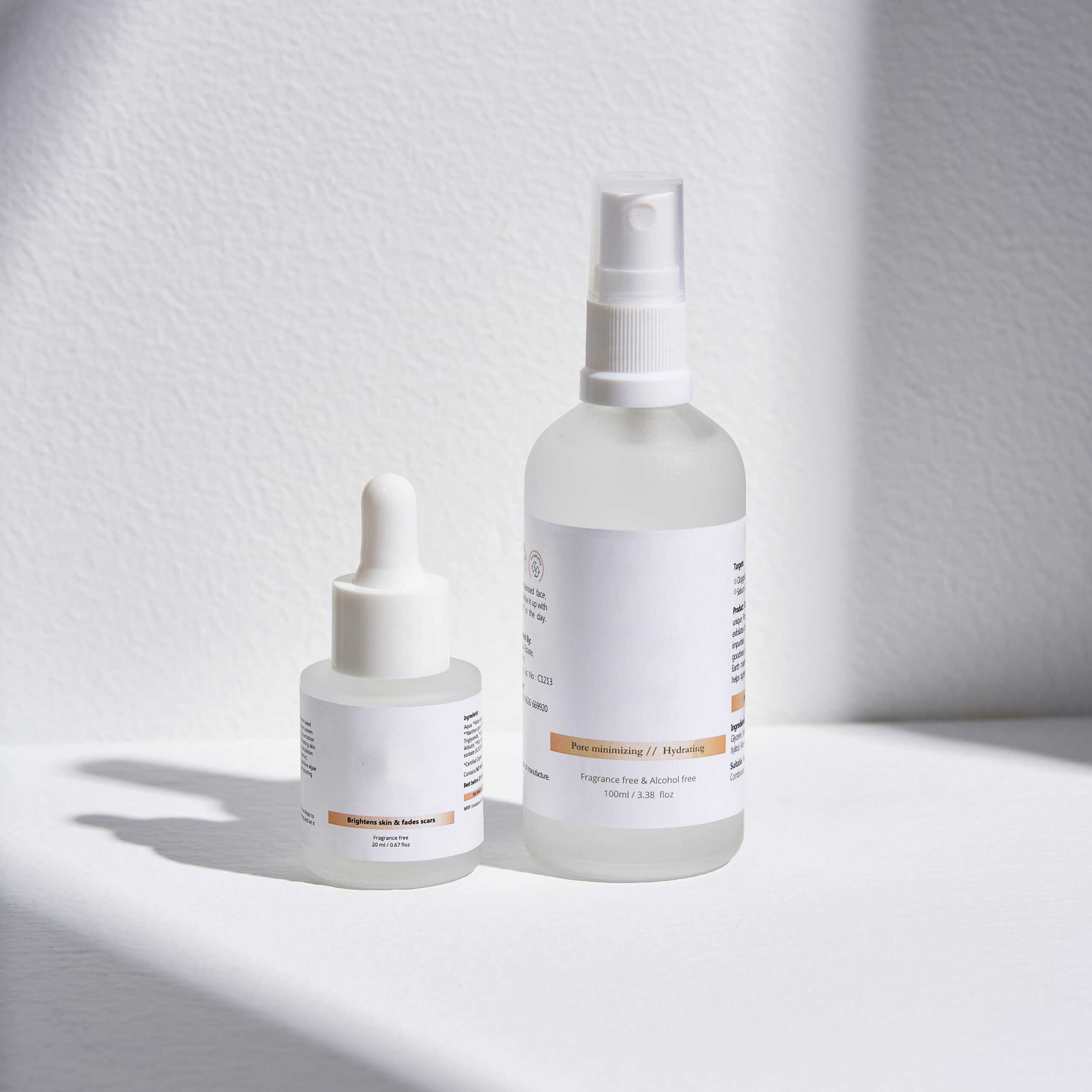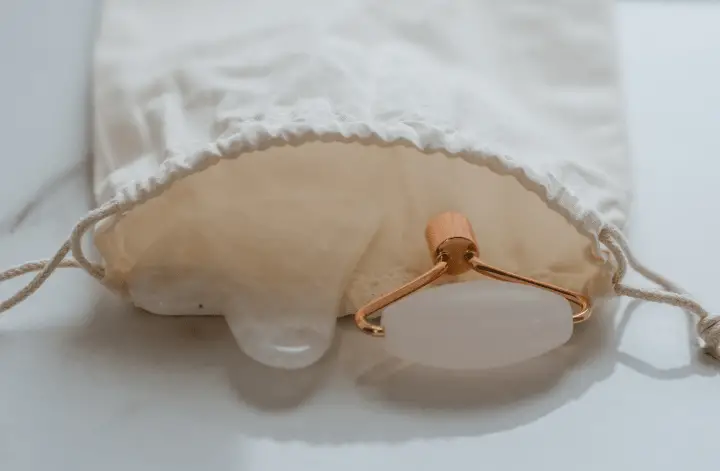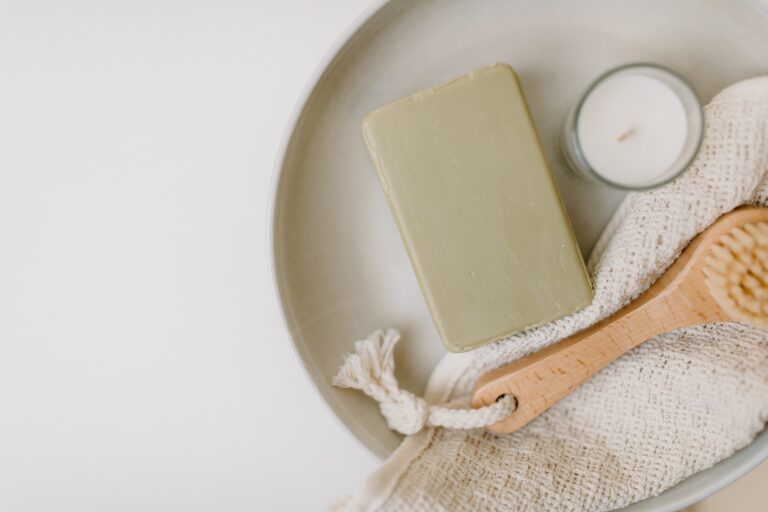One of my absolute favorite skincare makes of the last year has been a whole body DIY glycolic acid toner. I had tried the one from The Ordinary a while back and fell in love with the way it made my skin feel. Being me I immediately wondered to myself – “could I hack this??”. I got online and found a couple of sources (mostly video), but I was quite surprised that there wasn’t much information at all.
There were lots of stuff on how to make facial treatments and masks, using ingredients from which glycolic acid is derived (eg. sugar), but not much at all on how to make a ‘professional’ pH controlled glycolic acid toner – you know, ‘the business’.
I actually had to do quite a bit of ferreting around to get all the instructions, step by step and ingredient interaction info I needed before I felt confident in mixing my own.
Which is weird because it’s actually very straightforward and easy! Certainly less fussy than making a cream, let’s say.
So below you have a very basic and effective, completely DIY glycolic acid toner recipe you can safely make at home very quickly.
I’ll start with some glycolic acid basics and safety tips, before moving on to the equipment and ingredients you’ll need.
You then have the step by step process and the actual recipe amounts. At the end you also have a list of the different possible ways you can use this multipurpose DIY glycolic acid toner.
Glycolic acid basics
Glycolic acid is basically an AHA, an alpha hydroxy acid, that is considered one of the most powerful due to the fact that it has the smallest molecule size and a simple structure. It’s not the strongest of the AHA acids (this depends on the concentration of the solution), but it penetrates the skin deeper and better, resulting in a more in-depth effect.
It has anti-inflammatory, antibacterial, antioxidant and keratolytic properties (this means it breaks down the thickness of rough patches in the skin). It works by breaking the glue between the skin’s oils and the dead cells of the outer layer, speeding up skin renewal.
It can be derived from several natural sources, like pineapple, beets and cantaloupe, but it’s most commonly taken from the sugar cane.
The benefits of using glycolic acid
So why is glycolic acid such an amazing and basic ingredient to have in your skincare routine?
Related post: Your Holistic Guide To Repair a Damaged Skin Barrier Naturally
Most recommended for
Considering all of the above, glycolic acid toners are highly recommended for things like:
- Congested skin. So, blackheads, whiteheads, acne.
- Large pores and overall skin dullness.
- Hyperpigmentation (dark spots).
- Fine lines and wrinkles.
- Keratosis pilaris. Tiny bumps that usually show up on the arms, thighs and buttocks.
- Hyperkeratosis. Any thickening of the skin that might include keratosis pilaris, or eczema, psoriasis, corns and calluses, among many other things.
Glycolic acid safety tips
Possible side effects
These are the signs you may be using glycolic acid either too often or in too high a concentration:
- Tingling or itching
- Redness or irritation
- Dryness, peeling or flaking
- Purging (worsening of acne)
Skincare Interactions
Like any other skincare active, you need to be aware of the possible interactions with the rest of your skincare. I wrote a previous blog post on how to layer skincare products correctly, where I also went into more depth about the DOs and DON’Ts of skincare active interaction, if you want to learn more about it. But as far as glycolic acid is concerned:
Avoid mixing
OK to mix
Equipment & Ingredients
Below are the basic ingredients and equipment you’ll need to make this glycolic acid toner. This toner recipe is very basic, simple and straightforward – just the way we like it here!
Equipment
- 9 oz (250 ml) beaker / measuring cup
- Dropper
- pH strips
- Stirring metal spoon
- Digital scale
- Paper towels
- Rubbing alcohol
- 9 oz (250 ml) glass bottle with spray or applicator or similar repurposed bottle (for the finished product)
Ingredients
- Distilled water or hydrosol (herbal water – rose, lavender, chamomile, etc.)
- Glycolic acid powder
- Glycerin (humectant)
- Leucidal Liquid (preservative)
- Citric acid (to lower pH, if necessary)
- Baking soda (to raise pH, if necessary)
Related post: A Simple DYI Skin Barrier Repair Cream (3 ways)
The steps – how to make a DIY glycolic acid toner
Step 1 – Sterilize the equipment
Take a paper towel and soak it in rubbing alcohol. Use it to wipe the measuring cup, the stirring spoon and the dropper. You can add a bit of alcohol to the measuring cup and pick it up with the dropper, in order to sterilize the inside of it. Just squeeze it back out to dispose of it.
Put the spoon and the dropper in the cup and set aside for 10 minutes, so that the alcohol has time to do its thing.
Step 2 – Weigh and mix the ingredients
You can weigh every ingredient separately or all directly inside the measuring cup, taring (zeroing out) the scale before adding each of the ingredients.
It’s preferable to weigh them separately simply because you won’t be able to remove excess if you pour in too much. But if you have a steady wrist and quick reflexes, feel free to go for it.
So, add the glycolic acid powder and the glycerin to the water (or hydrosol) and mix well with the stirring spoon, until you see that the glycolic acid powder has completely dissolved.
Step 3 – Check the pH and adjust
Glycolic acid needs an acidic environment to do its thing. In its natural state it hovers around a 1.7 pH. However, this is far too acidic for the health of the skin, which prefers a pH between 4.7 and 5.75 (preferably under 5).
An effective and safe glycolic acid toner should have a pH between 3.5 and 4.
So, take the pH strip and check the pH of the toner against the color code provided by the manufacturer.
If the pH is under 3, or closer to 3 than 4, add a few drops of the alkalinizing pH adjuster (with baking soda – recipe below). Check the pH again and add more if it’s still too low. You might have to do it a few times until the pH is closer to 4.
If the pH is over 4, add a few drops of the acidifying pH adjuster (with citric acid – recipe below) and check again. And so on, until the pH is correct.
Step 4 – Add the preservative
The preservative I’m using here is Leucidal Liquid, which is a natural fermentation-based preservative. It’s effective within the 3 – 8 pH range.
The ingredient amounts in this recipe are supposed to produce a product with a pH between 3 and 4, but small differences in the weighed amounts (depending on the accuracy the scale) might produce a different end pH.
That’s why we need to always check the pH and make adjustments with a pH adjuster, if necessary.
For this reason, I hold off adding the preservative until I’ve made sure that the pH of the toner is not too low. I don’t want to risk “killing” the good microorganisms that are responsible for the preservation ability of the preservative I’m using.
If you’re using a different preservative and it’s not sensitive to pH, feel free to switch these last two steps around – you can add the preservative first and check the pH as the last step.
6-7% Glycolic Acid toner recipe (pH 3.5 – 4)
This DIY glycolic acid toner recipe makes about 9 oz (or 250 ml).
main ingredients
- 7 oz (200 gr.) Water or soothing hydrosol
- 0.5 oz (15 gr.) Glycolic acid powder
- 0.4 oz (10 gr.) Glycerin
- 0.2 oz (5 gr.) Preservative
pH adjuster (if necessary)
pH adjuster recipes
Acidifying (citric acid)
- 1.8 oz (50 gr.) Distilled water
- 1.8 oz (50 gr.) Citric acid powder
Just mix thoroughly until the powder has dissolved.
Alkalinizing (baking soda)
- 1.8 oz (50 gr.) Distilled water
- 1.8 oz (50 gr.) Baking soda
Just mix thoroughly until powder has dissolved.
Ways you can use this DIY glycolic acid toner
You can use this toner on your face or your body. My preferred method of use is as a whole body treatment, to gently exfoliate and soften any rough areas, like elbows, knees and feet.
I usually put it on in the morning after my cold shower (literally just a jolt of cold water), but I will also rub it on even if I skip the shower.
I will usually take a proper cleaning shower (with soap) in the evenings, followed by just moisturizer. This works well for my skin – it feels soft, smooth and moisturized.
But there are many different ways you can use this glycolic toner.
As a gentle body exfoliant/treatment
Like I explained above. You can rub it all over your body to gently exfoliate, soften and treat the skin over time. It’s a leave-in product, so you can just massage it in until it absorbs.
If you only take one shower a day, you can apply your moisturizer after the glycolic acid toner, or you can alternate days where you apply the glycolic acid toner and days when you apply the moisturizer.
As a face toner
Preferably in the evening, as a nighttime treatment. Since the skin on your face is more sensitive than the skin on your body, do a patch test first and start slow.
Apply 3 or 4 times a week and if there is no reaction, you can increase it until you’re applying it every day. Always apply a moisturizer on top and don’t forget the sunscreen if you’re using it in the daytime.
As deodorant
The antibacterial and acidic nature of glycolic acid can be very useful as a deodorant. It won’t serve as an antiperspirant – meaning, it won’t stop you from sweating – but it will help neutralize the odor causing bacteria in your armpits.
As a spot treatment
Glycolic acid is amazing for dry and rough skin patches, so you can use it locally on areas like your elbows and feet. You can apply it once or twice a day for this purpose.
A great way to get rid of cracked feet is to apply the glycolic acid before you go to bed, followed by a rich moisturizer or body butter and put on cotton socks to enhance the treatment. If you don’t want to fuss with all that, just rub it into your heels until it absorbs properly.
As a scalp treatment
As an antibacterial chemical exfoliant, it’s also wonderful for scalp issues or as a chemical scalp scrub, that will help slough off the dead skin cells and resurface new ones.
You can apply it to your scalp with some cotton wool a few hours before you wash your hair, or even apply it at night a few days a week.
Related post: 3 Simple & Effective DIY Scalp Scrubs
How long until you see results
When glycolic acid is used as a toner, it will of course depend on the frequency of use and concentration of your product.
For regular use, you’ll see some results after 2 or 3 weeks, but it might take a few months to see major or significant improvements.
I’m so happy I learned how to make this stuff myself – the one from The Ordinary is very decently priced, but nothing beats getting ingredients in bulk and being able to make my own a thousand times over for the same price. OK, not literally a thousand times, but you know what I mean.
If you’re up for making your own, I hope you find this useful and easy to follow. If anything isn’t clear enough or you have any questions, please let me know and I’ll try to clarify.








